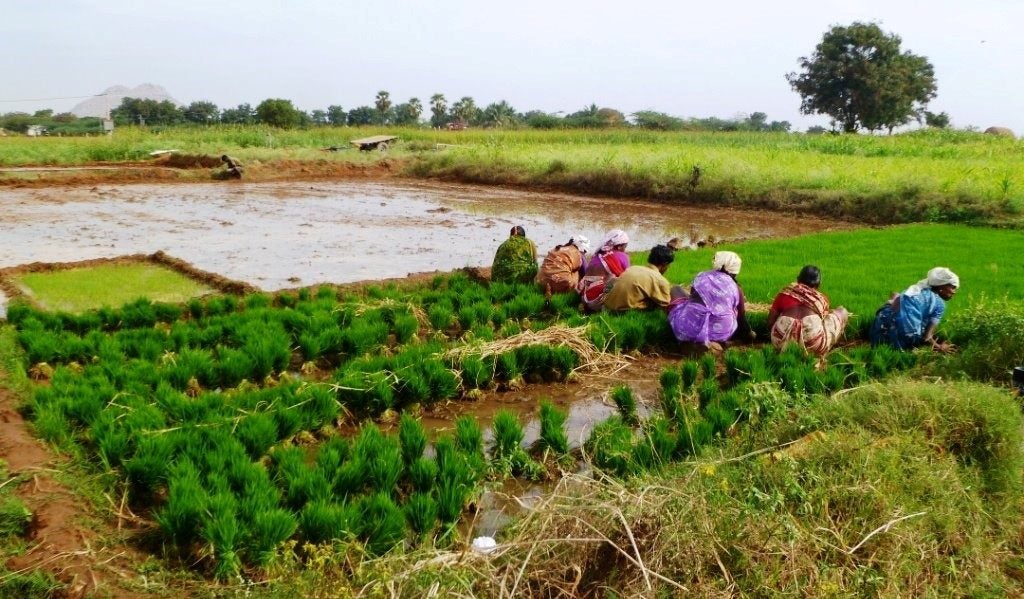This blog was co-authored by Kritee, Jeremy Proville, Terry Loecke, Richie Ahuja
Rice is a critical global crop: it provides livelihood to 150 million households and is a staple for half of humanity. However, it uses 11% of arable land and a third of irrigation water. In addition, continuously flooded rice fields are like wetlands and known to produce about 12% of total anthropogenic methane (CH4), a powerful short-lived greenhouse gas. Despite being one of the few crops whose climate impacts have been deeply studied over two decades, the potential of large emissions of nitrous oxide (N2O), a long-lived greenhouse gas, from rice cultivation was surprisingly missed until recently.
Given that the United Nations Framework Convention on Climate Change (UNFCCC) negotiators working on agricultural mitigation are set to review the issue of water and nitrogen management in early 2019, it is crucial that the climate impacts of rice cultivation are determined and lowered over both the long- and short-term.
Our latest study, recently published in Proceedings of the National Academy of Sciences, highlights the previously underestimated role of nitrous oxide emissions from rice farms as a global climate accelerator. The study also shows a clear opportunity to mitigate those emissions if effectively managed. Through our large empirical dataset from intermittently flooded rice farms in India, we find that the emission factor (percentage of added nitrogen converted to nitrous oxide) for rice farms can be 45 times higher than the maximum reported by previous research studies (0-0.7% vs up to 31%).
In an accompanying analysis, we also show that the scale of nitrous oxide emissions from rice farms worldwide under intense forms of intermittent flooding could be large (with 100-y global warming potential of 450 – 700 MMT CO2e100). This addition could increase the global contribution of rice cultivation from ~15% of agricultural GHG emissions to 25% and make the total climate impact of global rice cultivation potentially equivalent to 600 medium sized coal power plants (up to 1,930 MMT CO2e100), when the climate impact of methane from global rice cultivation is included. In this analysis, we also highlight potential hotspots of rice-associated nitrous oxide emissions across the world that should be the focus for future research.
The global climate and agriculture community has been focused on water management of rice fields (i.e., alternate wetting and drying, also called intermittent flooding) without adequately accounting for the potential adverse impact on N2O emissions. This focus is based on the untested assumption that almost all irrigated rice fields are continuously flooded and that most of the climate impact of rice production is due to methane emissions. Our data, which is based on very high frequency measurements of greenhouse gas emissions (GHG), suggests that N2O emissions increase as the degree to which fields are flooded decreases. The new research brings into focus net emissions from rice production as well as the trade-off between N2O and CH4 emissions, which impact the climate over different time scales.
Intermittent flooding at rice farms is likely much more common (especially in South-Asia, Africa and South America) than acknowledged in existing academic studies and in reports by UNFCCC. As water stress becomes more common due to increasing temperatures and droughts in the tropics, more rice farmers will resort to using intermittent flooding practices. Additionally, international agencies are promoting intermittent flooding to reduce CH4 -emissions.
Our analysis suggests that the greater use of intermittent flooding practices will greatly increase N2O emissions. In fact, we assesse that the global climate impact of N2O emissions from rice fields could be 25 to 40 times current academic estimates if intense forms of intermittent flooding regimes are widely adopted. However, to date no major rice producing country reports rice-N2O or related emission factors to the UNFCCC. In other words, if N2O emissions from rice cultivation were included in the UNFCCC discussions, their impact would be much higher than previous research estimates, leading to an increase in the net climate impacts of global rice production.
There is a positive path forward. While current approaches to N2O mitigation focus on fertilizer management without adequate attention to centrality of water management, in our PNAS study, we empirically show that co-management of nitrogen and/or organic matter inputs with shallow (mild-intermittent) flooding regimes can mitigate both methane and nitrous oxide emissions at individual farms by up to 90%. Even without co-management of fertilizers, shallow flooding can decrease current global climate impact of irrigated rice farms by 50-60% (450-550 MMT tCO2e100 years), depending on current and future flooding scenarios. While regional studies need to ground-truth our modeling and extrapolations for different parts of the world, our guidelines can help farmers achieve higher yields and reduce costs associated with water (and fertilizer) use.
Additional research is necessary to determine and lower the climate impacts of rice cultivation over both the long- and short-term. Region-specific studies that map water use and measure the effects of multiple co-managed variables on CH4 and N2O emissions as well as on soil carbon—which wasn’t explored in this study—could fill these gaps. An improved understanding of the implications of GHG mitigation strategies currently being advocated must be integrated into our thinking as soon as possible.
For additional resources, including a global risk map of rice nitrous oxide emissions, visit edf.org/riceN2O
